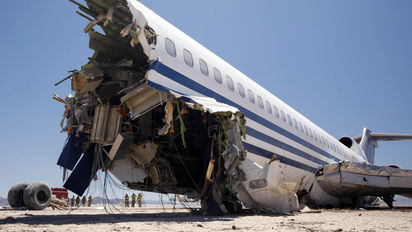Filmed from multiple angles, an empty Boeing 727 has been deliberately crashed in a remote Mexican desert as the centrepiece of a documentary on air safety.
The aircraft was piloted to the crash location before the pilot ejected, and the trijet then descended in a level attitude - guided remotely by a chase aircraft - before impacting hard and breaking up.
Video footage of the experiment shows the jet's forward fuselage breaking off before the 727 comes to a halt.
The crash took place in the Sonoran desert of Baja California, Mexico, for a television programme being made by the UK's Dragonfly Film and Television Produtions, in association with the US Discovery Channel, as well as Germany's Pro Sieben and the UK's Channel 4.
In a statement the producers say the crash "went according to plan and there were no injuries or damage to property".
Discussions over a deliberate crash had emerged a couple of years ago when the original plan was to seek a 300-seat widebody aircraft.
The 727 was carrying scientific measuring instruments, several cameras - including one on the pilot's helmet - and crash-test dummies, to record the effects on the airframe and passengers.
 |
Credit: Channel 4 |
"For safety reasons, an exclusion zone at the crash site was manned by security teams, as well as the Mexican military and police," the statement adds.
"Ahead of the crash, a full safety review of the project was undertaken by the highly-qualified pilots and commanders as well as the Mexican authorities which concluded that it was safe for all concerned."
The aircraft will be salvaged, it says, and an "extensive" clean-up performed following the experiment on 27 April.
NASA deliberately crashed a Boeing 720 in December 1984 to test a fuel additive designed to suppress fire - a test which did not go according to plan, because the aircraft impacted with a different attitude from that intended.
While the 727, like the 720, is a 1960s-era design, the producers of the new documentary claim that improvements in cameras and other technology justified revisiting the crash-test scenario.
"It's never been safer to fly, but we want to use this as an opportunity to provide scientific data that might help to improve passenger safety in those extremely rare cases when a catastrophic aircraft accident does occur," says Dragonfly executive producer Sanjay Singhal.
Related links:
- VIDEO: NASA and the Controlled Impact Demonstration
- FREE REPORT: The public perception of air safety
- ANNUAL REVIEW: Airline Safety & Losses 2011
Source: Flight International
















